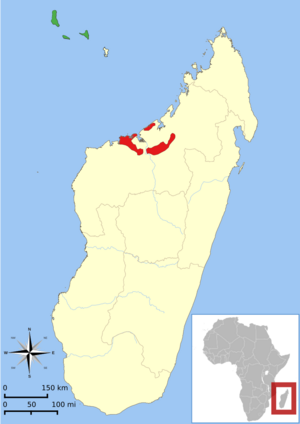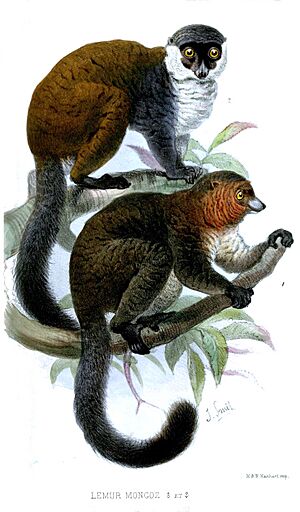Mongoose lemur facts for kids
Quick facts for kids Mongoose lemur |
|
|---|---|
 |
|
| Mongoose lemur at Cleveland Metroparks Zoo | |
| Conservation status | |
| Scientific classification | |
 |
|
| Distribution of E. mongoz: red = native, green = introduced | |
| Synonyms | |
|
The mongoose lemur (Eulemur mongoz) is a small primate that lives in trees. It belongs to the Lemuridae family. These lemurs are originally from Madagascar. They were also brought to the Comoros Islands.
Mongoose lemurs have pointed faces and long, bushy tails. Their fur is dark brown on top and pale on their bellies. They also have beards! Males have reddish beards, while females have white ones. These lemurs live in small family groups. They mostly eat fruit, but also enjoy leaves, flowers, and nectar. During the dry season, they eat a lot of nectar from Ceiba pentandra trees. Sadly, their numbers have dropped a lot. This is because their homes are being destroyed and they are hunted. The International Union for Conservation of Nature says they are "critically endangered".
Contents
What Does a Mongoose Lemur Look Like?
Mongoose lemurs are small, growing to be about 30 to 45 centimeters (12 to 18 inches) long. Their tails are even longer, measuring 40 to 64 centimeters (16 to 25 inches).
When they are born, both male and female mongoose lemurs have white beards. But around six weeks old, you can easily tell them apart. Males grow reddish beards and red cheeks. Their faces also look lighter than the females'. Sometimes, male lemurs even get a bald spot on their heads. This happens when they rub their heads to mark their territory.
Where Do Mongoose Lemurs Live?
Mongoose lemurs live in different types of forests. In Madagascar, they live in dry deciduous forests. On the Comoros islands, they live in humid forests.
It's interesting because the mongoose lemur is one of only two lemur species found outside of Madagascar. However, they were brought to the Comoros islands by people, so they are an introduced species there.
What Do Mongoose Lemurs Eat?
Mongoose lemurs mainly eat fruit. But they also enjoy flowers, leaves, and nectar. During the dry season, nectar from the non-native kapok tree (Ceiba pentandra) can make up almost 80% of their diet in some areas.
Because they eat fruit and nectar, mongoose lemurs help their environment. They act as pollinators, helping plants make seeds. They also spread seeds around, which helps new plants grow. Sometimes, they have even been seen eating grubs and beetles.
Daily Life and Family
Mongoose lemurs are special because their activity changes with the seasons. They are active during the day (diurnal) in the wet season. But when the weather gets hotter in the dry season, they become active at night (nocturnal).
These lemurs are very good at living in trees (they are arboreal). They can jump several meters from one tree to another! They live in small family groups. These groups usually have a male and female pair, plus one to three of their young. These family groups rarely meet other groups. When they do, they can be quite aggressive towards each other.
Young lemurs are usually born just before the rainy season, between August and October. Pregnancy lasts about four months. The babies drink their mother's milk for about five months. They usually stay with their parents until they are three years old, which is when they become fully grown.
The mongoose lemurs' breeding, eating, and daily activities change with the seasons. The amount of food available also affects their behavior. For example, female lemurs might be more in charge, and groups stay small when food is scarce.
Why Are Mongoose Lemurs Endangered?
Mongoose lemurs in zoos can live for up to 26 years. In the wild, they usually live for 18 to 20 years. However, mongoose lemurs in the wild face many dangers. Their forest homes are being destroyed and broken into smaller pieces. They are also hunted by people.
Their numbers have gone down by about 80% in just 25 years. Because of this, the International Union for Conservation of Nature has listed them as "critically endangered." This means they are at a very high risk of disappearing forever. While they are more endangered in Madagascar, there is hope for their conservation in the Comoros. Their population there seems to be growing.



